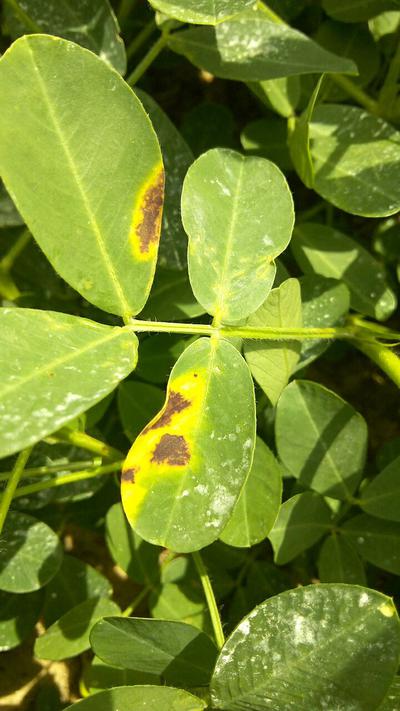Alternaria Leaf Spot Peanut
Alternaria sp.
Fungus
In a Nutshell
- Small brown spots with yellow halo.
- Lesions extend to midrib of leaf.
- Leaves curl inward and become brittle.
- Yellowing and withering of leaves.
- Defoliation.
Can also be found in
Symptoms
A. arachidis produces small brown, irregular-shaped spots surrounded by a yellowish halo on leaves (leaf spot). A. tenuissima causes a ‘v’ shaped blighting on the apical portions of leaflets. Later, the dark-brown lesion extends to the midrib and the entire leaf shows a blighted appearance, curls inwards and becomes brittle (leaf blight). Lesions produced by A. alternata are small, round to irregular in shape and spread over the whole leaf. They are first chlorotic and water-soaked, but as they enlarge, they turn necrotic and also affect the adjacent veins (leaf spot and veinal necrosis). The central portions rapidly dry up and disintegrate, giving the leaf a ragged appearance and leading to defoliation of the plant.
Recommendations

Organic Control
No effective alternative treatment has been found against this disease so far. Spraying of 3g/l of copper oxychloride after appearance of symptoms is very effective against this disease.

Chemical Control
Always consider an integrated approach with preventive measures together with biological treatment if available. Chemical control measures include the foliar application of mancozeb (3 g/l of water) after the first symptoms have appeared.
What caused it?
These diseases are caused by three soil-borne fungi of the Alternaria species. Infected seeds can be the primary source of inoculum. If they are planted and the environmental conditions are favorable, severe losses can occur. The secondary spread between plants is facilitated by wind movement and by insects. Temperatures above 20°C, prolonged leaf wetness, and high humidity favor the spread of the disease. The incidence may be important on peanut crops irrigated during the post-rainy season. Depending on the occurrence and severity of the disease, pod and fodder yields can be reduced up to 22% and 63% respectively.
Preventive Measures
- Use seeds from healthy plant material or certified pathogen-free seeds.
- Use resistant or tolerant cultivars.
- Remove weeds, alternate hosts and volunteer plants from fields.
- Check the fields for any sign of disease whenever conditions are favorable for the pathogens.
- Handpick and destroy infected plants found in the seedbeds or fields.
- Crop rotation with non-host crops is recommended for a minimum of three years.
- Avoid working in the field when foliage is wet.
- Plow deep to rid the soil from any remaining pathogen.



